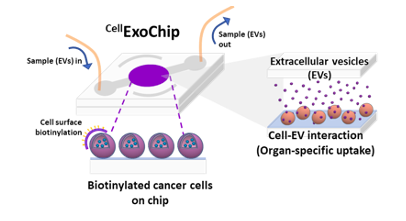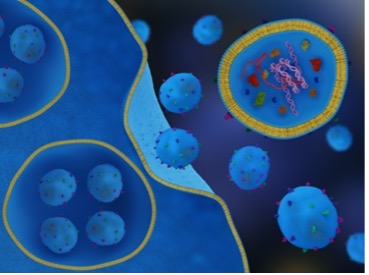Evaluation of Cell-Extracellular Vesicle Interaction using Novel Microfluidic Microsystem (CellExoChip)
TECHNOLOGY NUMBER: 2022-134


OVERVIEW
A microfluidic evaluation method to detect uptake of extracellular vesicles EVs by cell of origin
• Enables preferential uptake of exosomes by organ-specific selectivity
• May be used for diagnosis, prognosis, or treatment response in cancer patients
BACKGROUND
Extracellular vesicles (EVs) are cell-derived vesicles that are released into the extracellular environment to carry bioactive materials to recipient cells. This intracellular communication is increased in the setting of cancer cells, which release a higher number of EVs compared to normal cells. The study of EVs is therefore of significant interest as non-invasive biomarkers for neoplasm given that they may be recovered from various bodily fluids including, blood, urine, and saliva. The contents of EVs include RNAs and proteins that may reflect the molecular signature of a cancer and provide a measure for tumor cell aggressiveness as a surrogate for overall prognosis. Monitoring EV biomarker profiles during therapy may also provide an easy measure for treatment response. Current limitations of the use for EVs include volume requirements, time, sample complexity, heterogeneity among exosomes, and overlap of physical and chemical properties with other EVs contained in a sample. As such, a need exists for a method to overcome these constraints.
INNOVATION
Researchers have created a microfluidic evaluation method that chemically immobilizes cancer cells to enable uptake of their respective extracellular vesicles (EVs) for the purpose of screening organ specific EVs from heterogeneous biological samples. The methodology involves incubation of a sample comprised of multiple cell types in order to detect increased uptake levels of EVs which can be correlated with specific cells of origin. The microfluidic device facilitates an interaction between cells and certain EVs which enables preferential uptake of the exosomes by organ-specific cells due to organotropism. This approach bypasses the constraints of analyzing and profiling embedded proteins prior to EV isolation. One experiment confirmed uptake of lung cancer exosomes by cancer cell lines from the lung, bladder, and breast at a rate of 100%, 16%, and 40%, respectively. The CellExoChip device therefore allows for a simple reliable method to demonstrate the cell-exosome specific interaction, which can effectively screen specific EVs.
-
expand_more mode_edit Inventor (3)Yoontae KangSunitha NagrathZeqi Niu
-
expand_more library_books References (2)
- A. Hoshino et al. Nature 527 (2015), pp. 329–335. , Tumour exosome integrins determine organotropic metastasis. Nature 527 (2015), pp. 329–335.
- M. Sancho-Albero et al. , Cancer-derived exosomes loaded with ultrathin palladium nanosheets for targeted bioorthogonal catalysis. Nat Catal 2 (2019), pp. 864–872
-
expand_more cloud_download Supporting documents (1)Product brochureEvaluation of Cell-Extracellular Vesicle Interaction using Novel Microfluidic Microsystem (CellExoChip).pdf